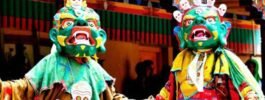Holi, also known as the Festival of Colors, is one of the most vibrant and joyous festivals celebrated in India and among Hindu communities around the world. This ancient festival has its roots deeply embedded in Hindu mythology and traditions, dating back centuries. The origins of Holi can be traced back to various mythological stories, with the most popular ones being the legends of Prahlada and Holika.
Mythological Roots
One of the most famous stories associated with Holi is the tale of Prahlada, a young devotee of Lord Vishnu. Prahlada’s father, Hiranyakashipu, was a tyrannical king who despised Vishnu and sought to eradicate his son’s devotion. Despite his father’s efforts to kill him, Prahlada’s unwavering faith in Vishnu saved him every time. In one instance, Holika, Hiranyakashipu’s sister, attempted to burn Prahlada alive. However, due to his pure devotion, Prahlada emerged unscathed while Holika perished in the flames. This event symbolizes the victory of good over evil and the triumph of devotion.
Another legend associated with Holi is the playful antics of Lord Krishna, a Hindu deity known for his love for Radha and his mischievous nature. Krishna, along with his friends, would play pranks by drenching each other in colored water and smearing each other with colored powders. This tradition of playful celebration is believed to have evolved into the colorful and exuberant festival of Holi that we know today.
Cultural and Religious Significance
Holi holds immense cultural and religious significance in Hindu tradition. It marks the arrival of spring, a season of renewal and rejuvenation. The festival is celebrated with great fervor and enthusiasm, symbolizing the victory of good over evil, the arrival of spring, and the blossoming of love and unity.
The rituals and customs associated with Holi vary across different regions of India, but the essence of the festival remains the same – to spread joy, love, and harmony among people. The festival also serves as a reminder of the importance of forgiveness and letting go of past grievances, as people come together to bury old hatchets and start afresh.
Holi is not just a festival of colors; it is also a time for family gatherings, feasting on traditional delicacies, singing and dancing to festive songs, and spreading happiness and goodwill. The vibrant colors used during Holi are believed to represent the various hues of life and the diversity of nature, fostering a sense of unity and equality among people.
Evolution of Holi Celebration
Over the years, the celebration of Holi has evolved into a grand and colorful spectacle, attracting people from all walks of life. What was once a traditional religious festival has now become a global phenomenon, with people of all backgrounds coming together to partake in the joyous festivities.
In addition to the traditional rituals of smearing colors and drenching each other in colored water, modern Holi celebrations often include music festivals, dance performances, and cultural events. The festival has also become a popular theme in art, literature, and cinema, further spreading its message of love and unity to a wider audience.
In recent times, eco-friendly initiatives have been introduced to promote the use of natural and organic colors during Holi, reducing the environmental impact of the festival. This eco-conscious approach reflects a growing awareness of sustainability and responsible celebration practices among Holi enthusiasts.







